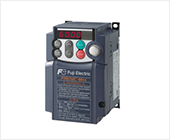Specifications
-
Lineup in Japan
-
FRENIC-VG
-
Product information
- Unit Type, Stack Type, Converters
- Comprehensive Line-up
- Improved Control Performance
- A Wide Range of Applications
- Easier Maintenance
- Easier Maintenance and Greater Reliability
- Adaptation to Environment and Safety
- How to expand the capacity range of the inverters (Stack Type)
- How to expand the capacity range of the PWM converters (Stack Type)
- Variation
- Applicable SiC Hybrid Module Model
- Specifications
- External Dimensions
-
Catalog Download
- Document Download
-
Product information
- FRENIC-MEGA (G2)
-
FRENIC-MEGA (G1)
-
Product information
- Best vector control for the general-purpose inverter in the class
- Accommodating various applications
- Wide model variation meeting the customer needs
- Supports for simple maintenance
- Network building
- Prolonged service life and improved life judgment function
- Consideration for environment
- Global compatibility
- Function Safety
- Variation
- Specifications
- External Dimensions
-
Catalog Download
- Document Download
-
Product information
-
FRENIC-Ace (E3)
- Product information
- Variation
- Specifications
- External Dimensions
-
Catalog Download
- Document Download
- FRENIC-Ace (E2)
- FRENIC-Mini
-
FRENIC-HVAC
- Product information
- Variation
- Specifications
- External Dimensions
-
Catalog Download
- Document Download
-
FRENIC-Eco
-
Product information
- Product appearance
- Exploded view of main body
- Keypad switches and functions
- Monitor display & key operation
- New energy-saving
- Long life design of inverters
- Simplified maintenance
- Optimum functions for HVAC
- Environment and panel design
- Operator-friendly features
- Network compatibility
- Global compatibility
- Variation
- Specifications
- External Dimensions
-
Catalog Download
- Document Download
-
Product information
-
FRENIC-Lift(LM1S)
- Product information
- Variation
- Specifications
- External Dimensions
-
Catalog Download
- Document Download
-
FRENIC-eRHR
- Product information
- Variation
- Specifications
- External Dimensions
-
Catalog Download
- Document Download
-
FRENIC-eRHC
- Product information
- Variation
- Specifications
- External Dimensions
-
Catalog Download
- Document Download
-
FRENIC-VG
-
Lineup in Europe
-
FRENIC-VG
-
Product information
- Unit Type, Stack Type, Converters
- Comprehensive Line-up
- Improved Control Performance
- A Wide Range of Applications
- Easier Maintenance
- Easier Maintenance and Greater Reliability
- Adaptation to Environment and Safety
- How to expand the capacity range of the inverters (Stack Type)
- How to expand the capacity range of the PWM converters (Stack Type)
- Variation
- Applicable SiC Hybrid Module Model
- Specifications
- External Dimensions
-
Catalog Download
- Document Download
-
Product information
- FRENIC-MEGA (G2)
-
FRENIC-MEGA (G1)
-
Product information
- Best vector control for the general-purpose inverter in the class
- Accommodating various applications
- Wide model variation meeting the customer needs
- Supports for simple maintenance
- Network building
- Prolonged service life and improved life judgment function
- Consideration for environment
- Global compatibility
- Function Safety
- Variation
- Specifications
- External Dimensions
-
Catalog Download
-
Product information
-
FRENIC-Ace (E3)
- Product information
- Variation
- Specifications
- External Dimensions
-
Catalog Download
- Document Download
- FRENIC-Ace (E2)
- FRENIC-Mini
- FVR-Micro
-
FRENIC-HVAC
- Product information
- Variation
- Specifications
- External Dimensions
-
Catalog Download
- Document Download
-
FRENIC-Eco
-
Product information
- Product appearance
- Exploded view of main body
- Keypad switches and functions
- Monitor display & key operation
- New energy-saving
- Long life design of inverters
- Simplified maintenance
- Optimum functions for HVAC
- Environment and panel design
- Operator-friendly features
- Network compatibility
- Global compatibility
- Variation
- Specifications
- External Dimensions
-
Catalog Download
- Document Download
-
Product information
- FRENIC-AQUA
-
FRENIC-Lift(LM1S)
- Product information
- Variation
- Specifications
- External Dimensions
-
Catalog Download
- Document Download
-
FRENIC-Lift(LM2A)
- Product information
- Variation
- Specifications
- External Dimensions
-
Catalog Download
- Document Download
-
FRENIC-eRHR
- Product information
- Variation
- Specifications
- External Dimensions
-
Catalog Download
- Document Download
-
FRENIC-eRHC
- Product information
- Variation
- Specifications
- External Dimensions
-
Catalog Download
- Document Download
-
FRENIC-VG
-
Lineup in North America
-
FRENIC-VG
-
Product information
- Unit Type, Stack Type, Converters
- Comprehensive Line-up
- Improved Control Performance
- A Wide Range of Applications
- Easier Maintenance
- Easier Maintenance and Greater Reliability
- Adaptation to Environment and Safety
- How to expand the capacity range of the inverters (Stack Type)
- How to expand the capacity range of the PWM converters (Stack Type)
- Variation
- Applicable SiC Hybrid Module Model
- Specifications
- External Dimensions
-
Catalog Download
- Document Download
-
Product information
- FRENIC-MEGA (G2)
-
FRENIC-MEGA (G1)
-
Product information
- Best vector control for the general-purpose inverter in the class
- Accommodating various applications
- Wide model variation meeting the customer needs
- Supports for simple maintenance
- Network building
- Prolonged service life and improved life judgment function
- Consideration for environment
- Global compatibility
- Function Safety
- Variation
- Specifications
- External Dimensions
-
Catalog Download
-
Product information
-
FRENIC-Ace (E3)
- Product information
- Variation
- Specifications
- External Dimensions
-
Catalog Download
- Document Download
- FRENIC-Ace (E2)
- FRENIC-Mini
-
FRENIC-HVAC
- Product information
- Variation
- Specifications
- External Dimensions
-
Catalog Download
- Document Download
-
FRENIC-Eco
-
Product information
- Product appearance
- Exploded view of main body
- Keypad switches and functions
- Monitor display & key operation
- New energy-saving
- Long life design of inverters
- Simplified maintenance
- Optimum functions for HVAC
- Environment and panel design
- Operator-friendly features
- Network compatibility
- Global compatibility
- Variation
- Specifications
- External Dimensions
-
Catalog Download
-
Product information
-
FRENIC-eRHR
- Product information
- Variation
- Specifications
- External Dimensions
-
Catalog Download
- Document Download
-
FRENIC-eRHC
- Product information
- Variation
- Specifications
- External Dimensions
-
Catalog Download
- Document Download
-
FRENIC-VG
-
Lineup in China
-
FRENIC-VG
-
Product information
- Unit Type, Stack Type, Converters
- Comprehensive Line-up
- Improved Control Performance
- A Wide Range of Applications
- Easier Maintenance
- Easier Maintenance and Greater Reliability
- Adaptation to Environment and Safety
- How to expand the capacity range of the inverters (Stack Type)
- How to expand the capacity range of the PWM converters (Stack Type)
- Variation
- Applicable SiC Hybrid Module Model
- Specifications
- External Dimensions
-
Catalog Download
- Document Download
-
Product information
- FRENIC-MEGA (G2)
-
FRENIC-MEGA (G1)
-
Product information
- Best vector control for the general-purpose inverter in the class
- Accommodating various applications
- Wide model variation meeting the customer needs
- Supports for simple maintenance
- Network building
- Prolonged service life and improved life judgment function
- Consideration for environment
- Global compatibility
- Function Safety
- Variation
- Specifications
- External Dimensions
-
Catalog Download
- Document Download
-
Product information
-
FRENIC-Ace (E3)
- Product information
- Variation
- Specifications
- External Dimensions
-
Catalog Download
- Document Download
- FRENIC-Ace (E2)
- FRENIC-Mini
- FVR-Micro
-
FRENIC VP
- Product information
- Variation
- Specifications
- External Dimensions
-
Catalog Download
-
For Europe
- For China
-
- Document Download
- FRENIC-Lift(LM1S)
- FRENIC-eRHR
-
FRENIC-eRHC
- Product information
- Variation
- Specifications
- External Dimensions
-
Catalog Download
- Document Download
-
FRENIC-VG
-
Lineup in Asia
-
FRENIC-VG
-
Product information
- Unit Type, Stack Type, Converters
- Comprehensive Line-up
- Improved Control Performance
- A Wide Range of Applications
- Easier Maintenance
- Easier Maintenance and Greater Reliability
- Adaptation to Environment and Safety
- How to expand the capacity range of the inverters (Stack Type)
- How to expand the capacity range of the PWM converters (Stack Type)
- Variation
- Applicable SiC Hybrid Module Model
- Specifications
- External Dimensions
-
Catalog Download
- Document Download
-
Product information
- FRENIC-MEGA (G2)
-
FRENIC-MEGA (G1)
-
Product information
- Best vector control for the general-purpose inverter in the class
- Accommodating various applications
- Wide model variation meeting the customer needs
- Supports for simple maintenance
- Network building
- Prolonged service life and improved life judgment function
- Consideration for environment
- Global compatibility
- Function Safety
- Variation
- Specifications
- External Dimensions
-
Catalog Download
- Document Download
-
Product information
-
FRENIC-Ace (E3)
- Product information
- Variation
- Specifications
- External Dimensions
-
Catalog Download
- Document Download
- FRENIC-Ace (E2)
- FRENIC-Mini
- FVR-Micro
-
FRENIC-HVAC
- Product information
- Variation
- Specifications
- External Dimensions
-
Catalog Download
- Document Download
-
FRENIC-Eco
-
Product information
- Product appearance
- Exploded view of main body
- Keypad switches and functions
- Monitor display & key operation
- New energy-saving
- Long life design of inverters
- Simplified maintenance
- Optimum functions for HVAC
- Environment and panel design
- Operator-friendly features
- Network compatibility
- Global compatibility
- Variation
- Specifications
- External Dimensions
-
Catalog Download
- Document Download
-
Product information
- FRENIC-AQUA
- FRENIC eHVAC
-
FRENIC-Lift(LM1S)
- Product information
- Variation
- Specifications
- External Dimensions
-
Catalog Download
- Document Download
-
FRENIC-eRHR
- Product information
- Variation
- Specifications
- External Dimensions
-
Catalog Download
- Document Download
-
FRENIC-eRHC
- Product information
- Variation
- Specifications
- External Dimensions
-
Catalog Download
- Document Download
-
FRENIC-VG
-
Lineup in Taiwan
-
FRENIC-VG
-
Product information
- Unit Type, Stack Type, Converters
- Comprehensive Line-up
- Improved Control Performance
- A Wide Range of Applications
- Easier Maintenance
- Easier Maintenance and Greater Reliability
- Adaptation to Environment and Safety
- How to expand the capacity range of the inverters (Stack Type)
- How to expand the capacity range of the PWM converters (Stack Type)
- Variation
- Applicable SiC Hybrid Module Model
- Specifications
- External Dimensions
-
Catalog Download
- Document Download
-
Product information
- FRENIC-MEGA (G2)
-
FRENIC-MEGA (G1)
-
Product information
- Best vector control for the general-purpose inverter in the class
- Accommodating various applications
- Wide model variation meeting the customer needs
- Supports for simple maintenance
- Network building
- Prolonged service life and improved life judgment function
- Consideration for environment
- Global compatibility
- Function Safety
- Variation
- Specifications
- External Dimensions
-
Catalog Download
- Document Download
-
Product information
-
FRENIC-Ace (E3)
- Product information
- Variation
- Specifications
- External Dimensions
-
Catalog Download
- Document Download
- FRENIC-Ace (E2)
-
FRENIC-Eco
-
Product information
- Product appearance
- Exploded view of main body
- Keypad switches and functions
- Monitor display & key operation
- New energy-saving
- Long life design of inverters
- Simplified maintenance
- Optimum functions for HVAC
- Environment and panel design
- Operator-friendly features
- Network compatibility
- Global compatibility
- Variation
- Specifications
- External Dimensions
-
Catalog Download
- Document Download
-
Product information
-
FRENIC-Lift(LM1S)
- Product information
- Variation
- Specifications
- External Dimensions
-
Catalog Download
- Document Download
-
FRENIC-eRHR
- Product information
- Variation
- Specifications
- External Dimensions
-
Catalog Download
- Document Download
-
FRENIC-eRHC
- Product information
- Variation
- Specifications
- External Dimensions
-
Catalog Download
- Document Download
-
FRENIC-VG
-
Lineup in Korea
-
FRENIC-VG
-
Product information
- Unit Type, Stack Type, Converters
- Comprehensive Line-up
- Improved Control Performance
- A Wide Range of Applications
- Easier Maintenance
- Easier Maintenance and Greater Reliability
- Adaptation to Environment and Safety
- How to expand the capacity range of the inverters (Stack Type)
- How to expand the capacity range of the PWM converters (Stack Type)
- Variation
- Applicable SiC Hybrid Module Model
- Specifications
- External Dimensions
-
Catalog Download
- Document Download
-
Product information
- FRENIC-MEGA (G2)
-
FRENIC-MEGA (G1)
-
Product information
- Best vector control for the general-purpose inverter in the class
- Accommodating various applications
- Wide model variation meeting the customer needs
- Supports for simple maintenance
- Network building
- Prolonged service life and improved life judgment function
- Consideration for environment
- Global compatibility
- Function Safety
- Variation
- Specifications
- External Dimensions
-
Catalog Download
- Document Download
-
Product information
-
FRENIC-Ace (E3)
- Product information
- Variation
- Specifications
- External Dimensions
-
Catalog Download
- Document Download
- FRENIC-Ace (E2)
- FRENIC-Mini
- FRENIC-Eco
-
FRENIC-Lift(LM1S)
- Product information
- Variation
- Specifications
- External Dimensions
-
Catalog Download
- Document Download
-
FRENIC-eRHR
- Product information
- Variation
- Specifications
- External Dimensions
-
Catalog Download
- Document Download
-
FRENIC-eRHC
- Product information
- Variation
- Specifications
- External Dimensions
-
Catalog Download
- Document Download
-
FRENIC-VG
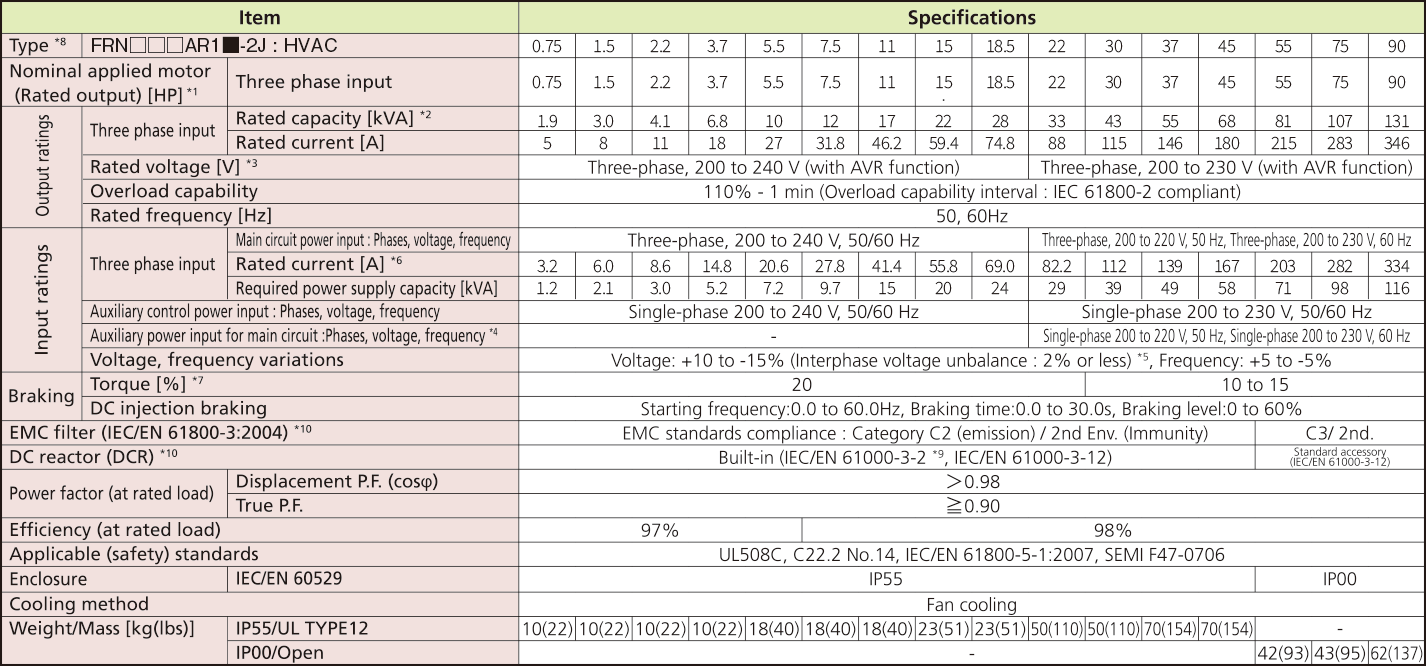
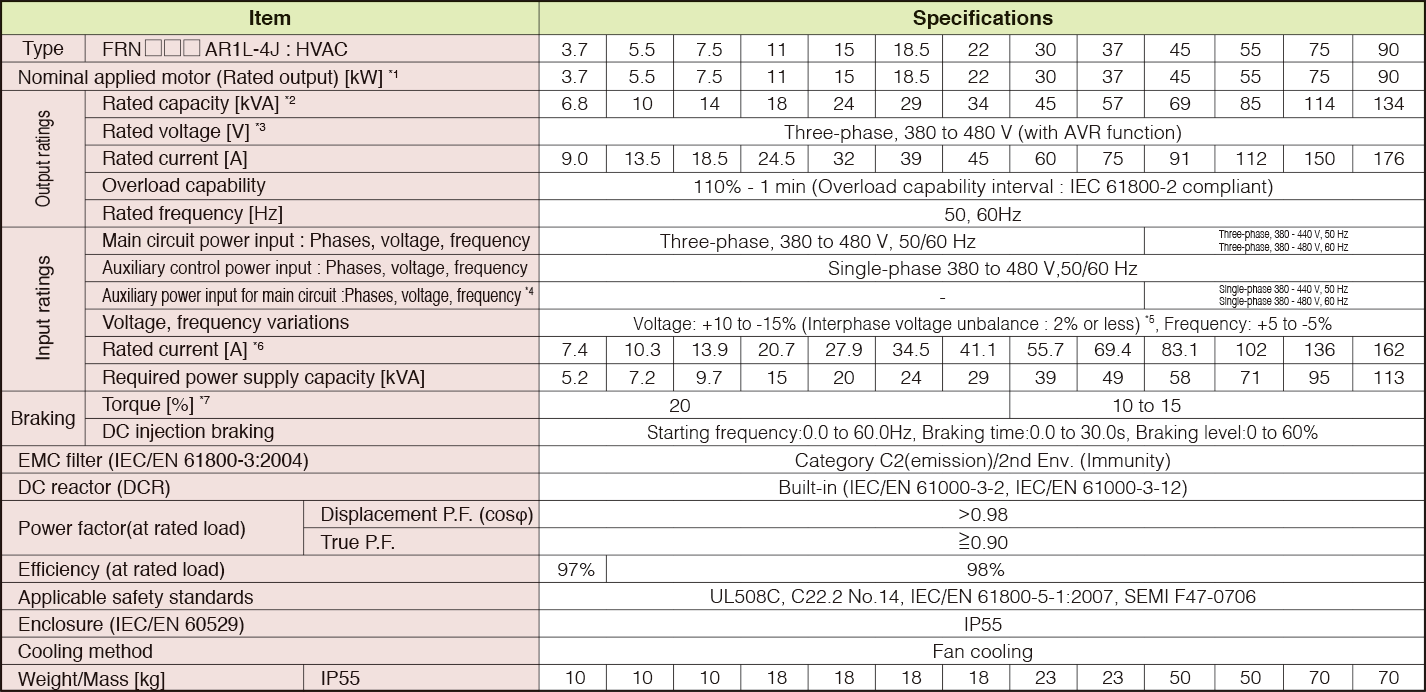
-
*1
-
Fuji 4-pole standard motor.
-
*2
-
Rated capacity is calculated by assuming the output rated voltage as 440 V.
-
*3
-
Output voltage cannot exceed the power supply voltage.
-
*4
-
The auxiliary power input is used as an AC power input when combining the unit to DC power supply such as high power factor PWM converter with power regenerative function. (Generally not to be used.)
-
*5
-
Voltage unbalance [%] = (Max. voltage [V] - Min. voltage [V])/Three-phase average voltage [V] x 67 (See IEC61800-3.) If this value is 2 to 3%, use an optional AC reactor (ACR).
-
*6
-
The value is calculated on assumption that the inverter is connected with a power supply 400V, 50Hz and Rsce=120.
-
*7
-
Average braking torque for the motor running alone. (It varies with the efficiency of the motor.)
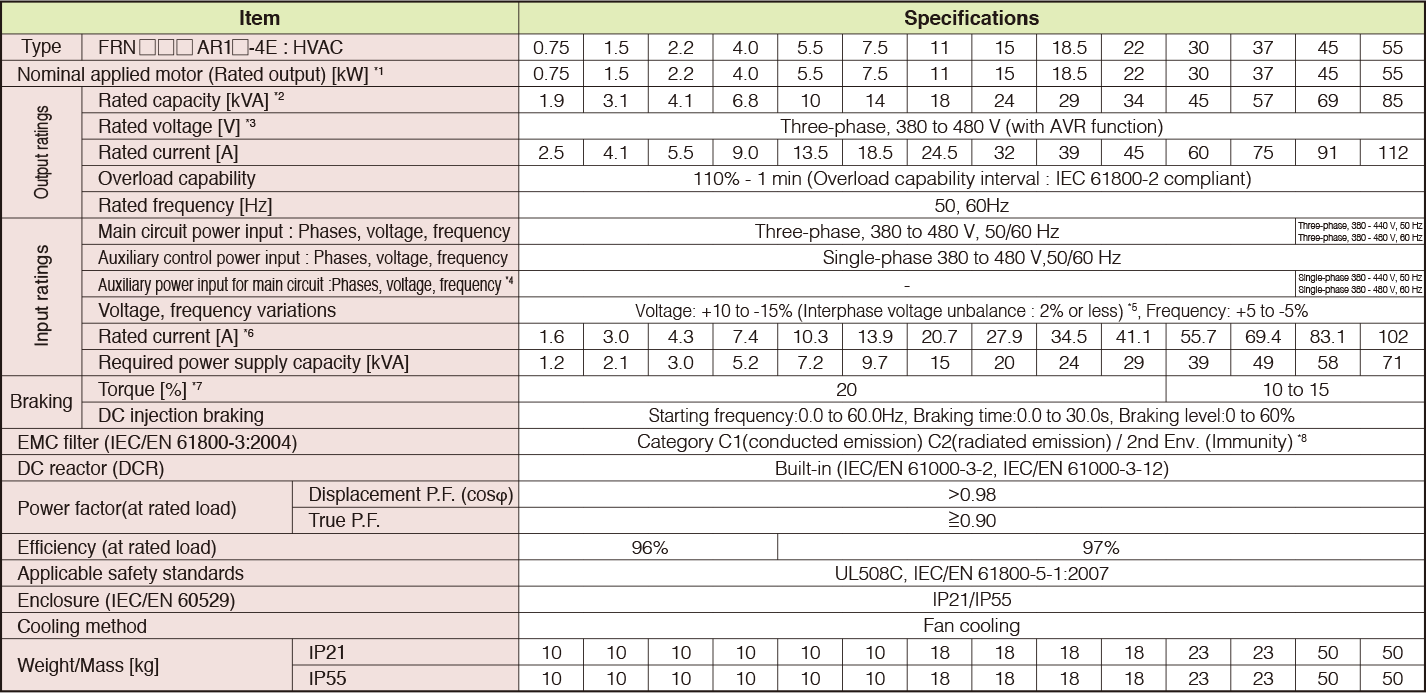
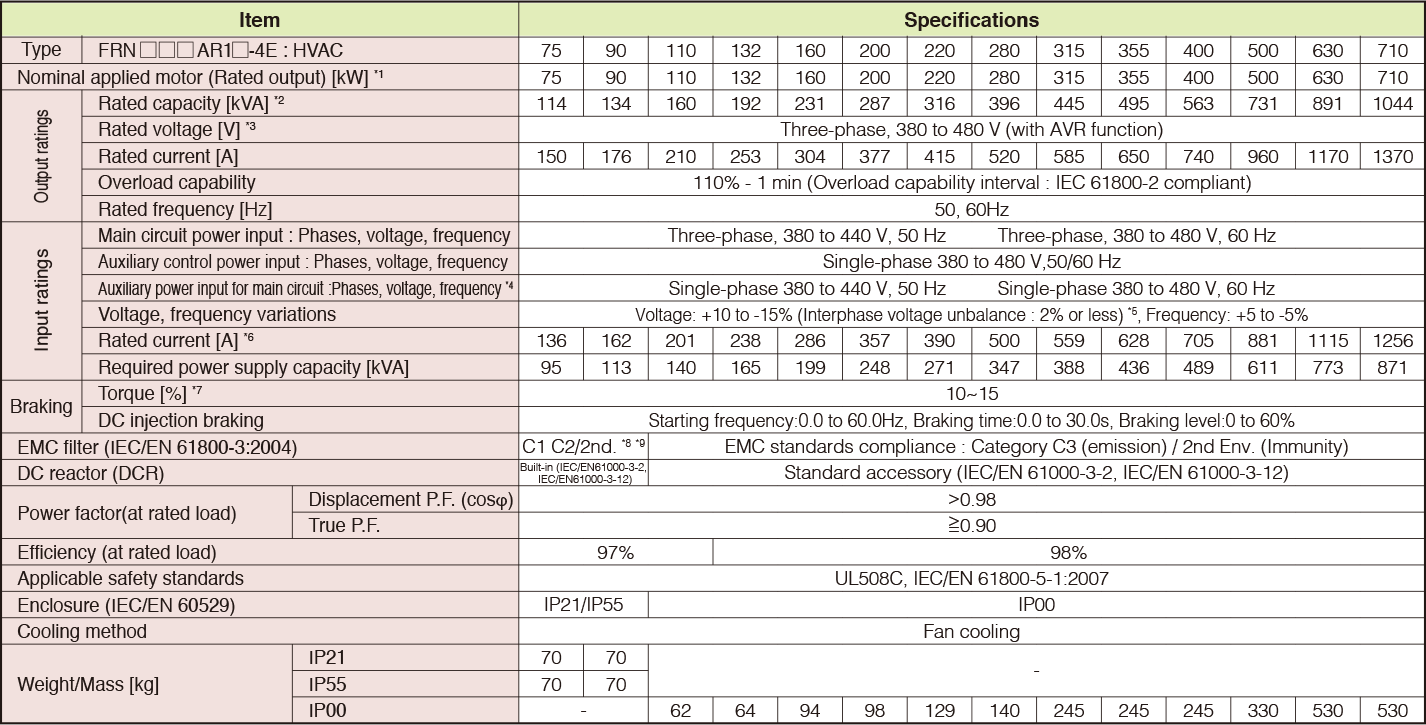
-
*1
-
Fuji 4-pole standard motor.
-
*2
-
Rated capacity is calculated by assuming the output rated voltage as 440 V.
-
*3
-
Output voltage cannot exceed the power supply voltage.
-
*4
-
The auxiliary power input is used as an AC power input when combining the unit to DC power supply such as high power factor PWM converter with power regenerative function. (Generally not to be used.)
-
*5
-
Voltage unbalance [%] = (Max. voltage [V] - Min. voltage [V])/Three-phase average voltage [V] x 67 (See IEC61800-3.) If this value is 2 to 3%, use an optional AC reactor (ACR).
-
*6
-
The value is calculated on assumption that the inverter is connected with a power supply 400V, 50Hz and Rsce=120.
-
*7
-
Average braking torque for the motor running alone. (It varies with the efficiency of the motor.)
-
*8
-
To provide compatibility for EMC category C1, ensure a motor power cable leng h of 10 m or less, a carrier frequency of 4kHz or less, and ground the E1 and E2 terminals.
-
*9
-
Category C1(conducted emission) C2(radiated emission) / 2nd Env. (Immunity)
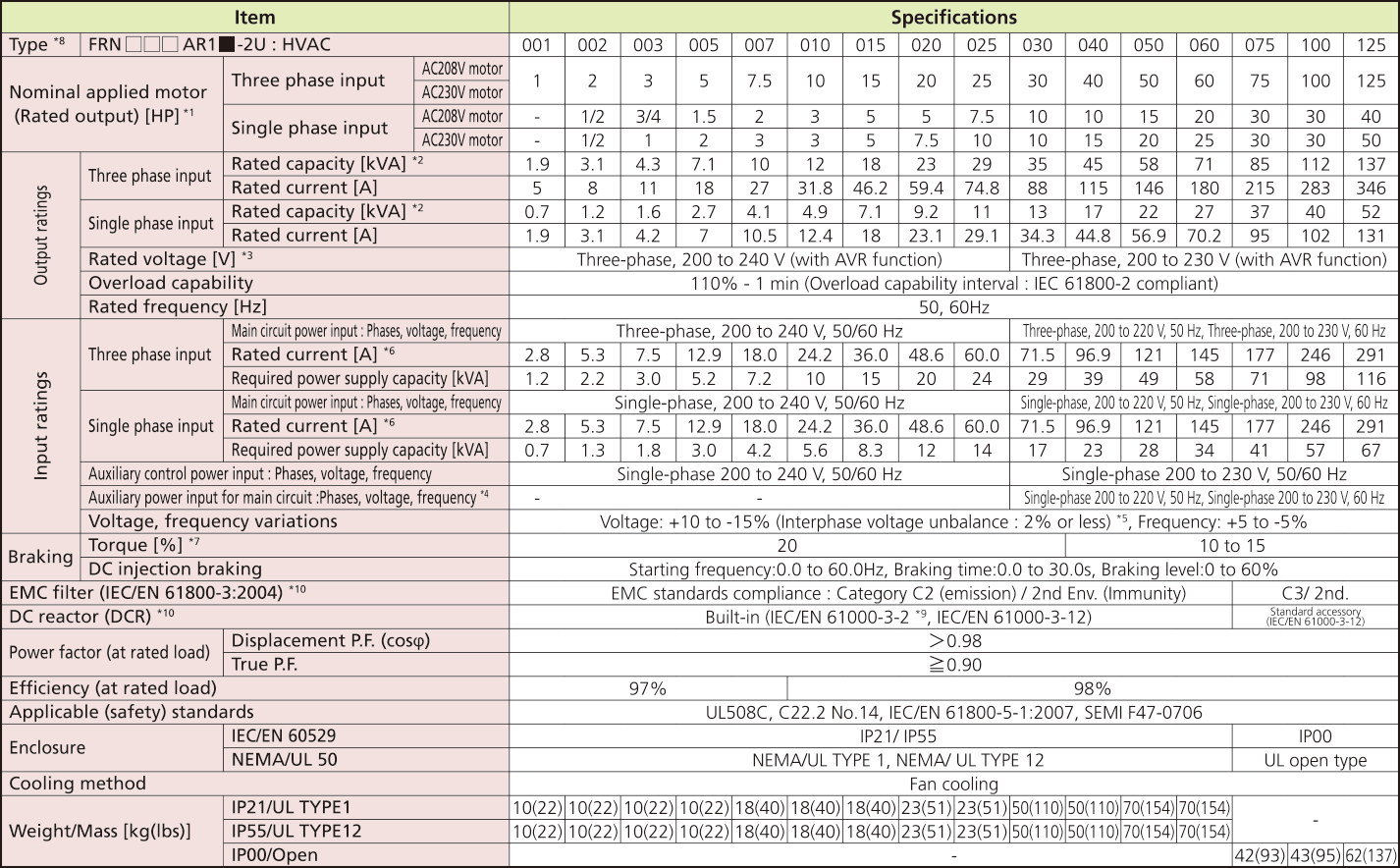
-
*1
-
US 4-pole standard induction motor.
-
*2
-
Rated capacity is calculated by assuming the output rated voltage as 230 V.
-
*3
-
Output voltage cannot exceed the power supply voltage. At single-phase input use, the output voltage may be lower than three-phase input.
-
*4
-
The auxiliary power input is used as an AC power input when combining the unit to DC power supply such as high power factor PWM converter with power regenerative function. (Generally not to be used.)
-
*5
-
Voltage unbalance [%] = (Max. voltage [V] - Min. voltage [V])/Three-phase average voltage [V] x 67 (See IEC61800-3.)If this value is 2 to 3%, use an optional AC reactor (ACR).
-
*6
-
The value is calculated on assumption that the inverter is connected with a power supply 230V, 50Hz and Rsce=120.
-
*7
-
Average braking torque for the motor running alone. (It varies with the efficiency of the motor.)
-
*8
-
The box (□) replaces an numeric letter depending on the drive capacity.
The box (■) replaces an alphabetic letter depending on the enclosure. M (IP21/UL TYPE1), L (IP55/UL TYPE12) or S (IP00/Open)
-
*9
-
It is applicable when the power supply is supplied from 3-phase 200V series transformer which is through 3-phase 400V series transformer.
-
*10
-
EMC filters and DCR does not conform to each corresponding standards when single phase input use.
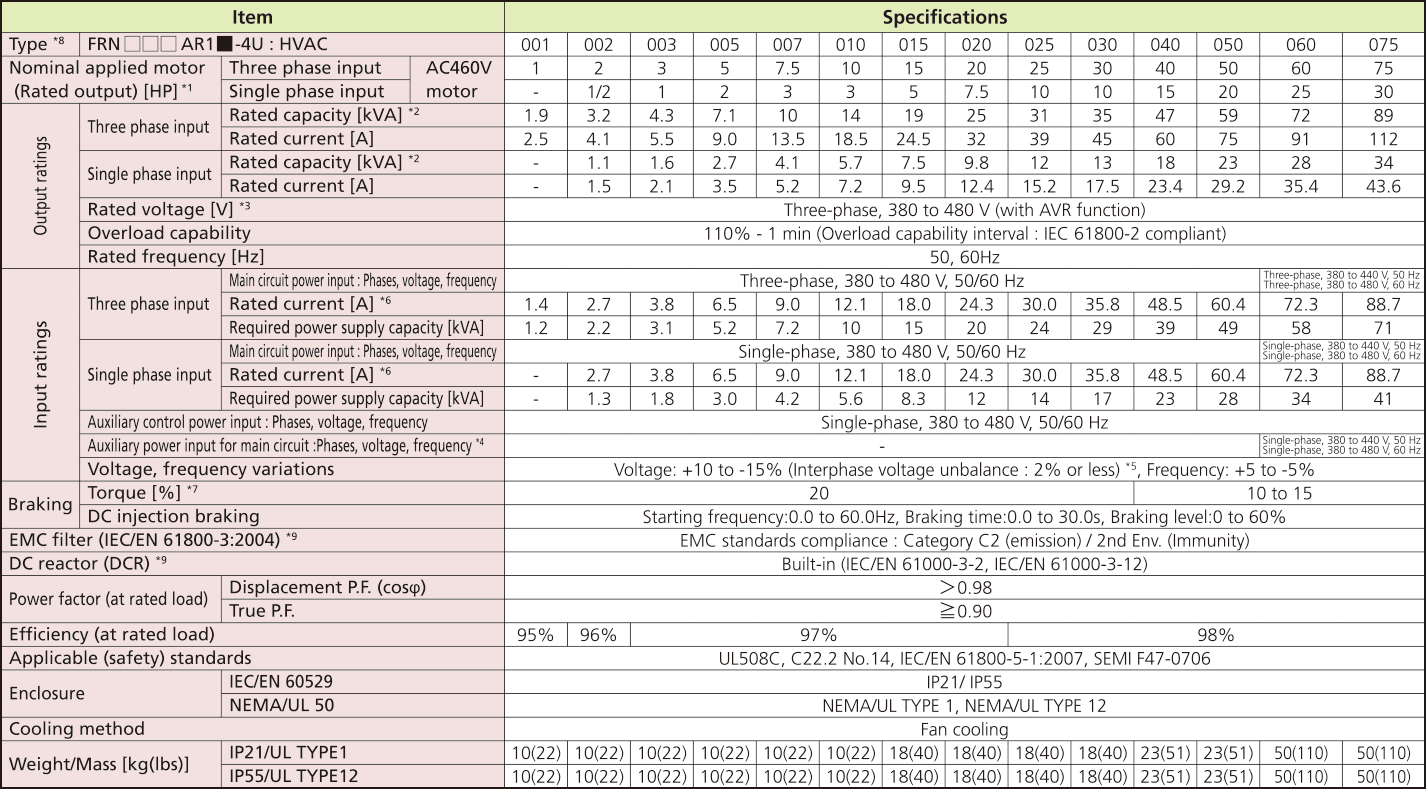
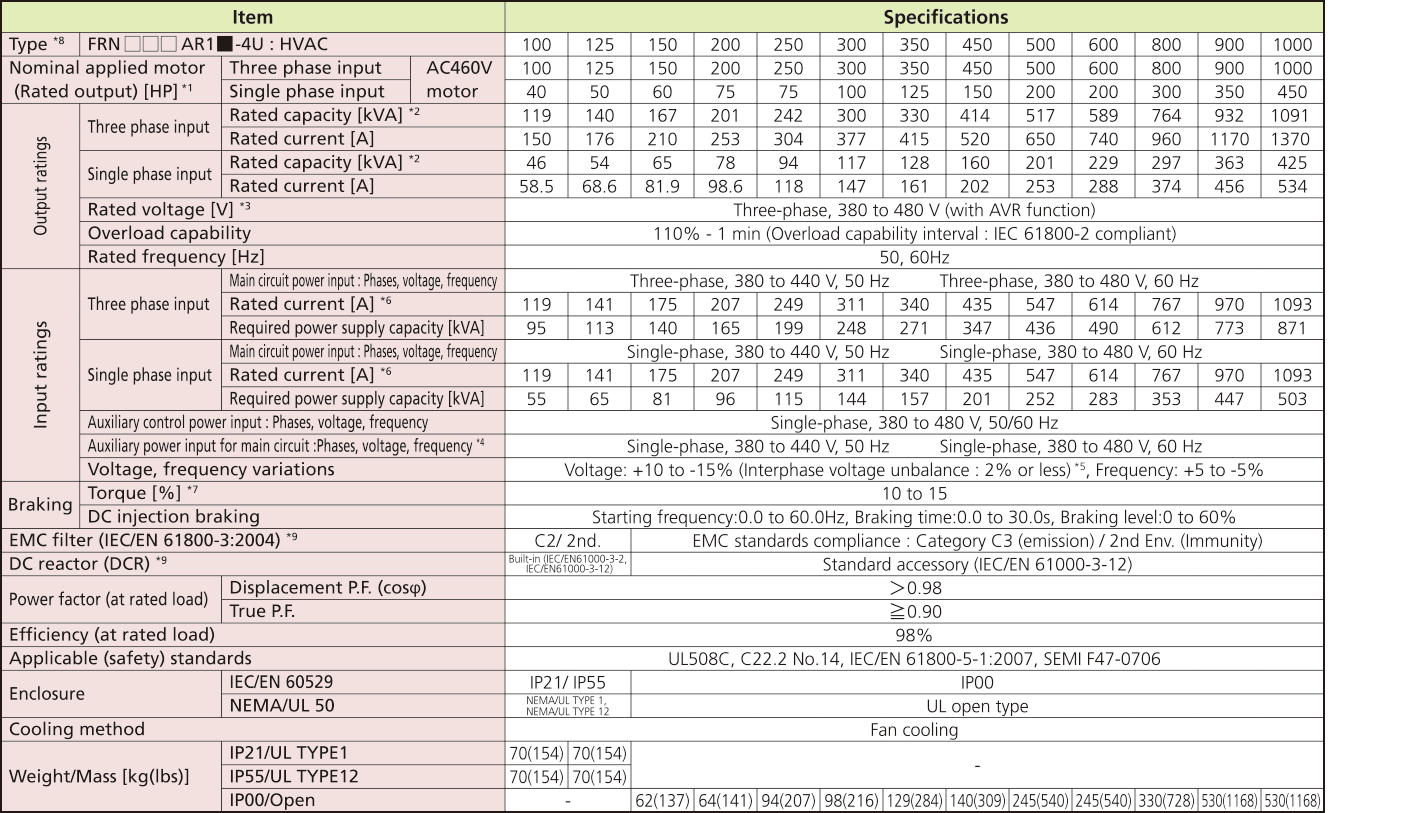
-
*1
-
US 4-pole standard induction motor.
-
*2
-
Rated capacity is calculated by assuming the output rated voltage as 460 V.
-
*3
-
Output voltage cannot exceed the power supply voltage. At single-phase input use, the output voltage may be lower than three-phase input.
-
*4
-
The auxiliary power input is used as an AC power input when combining the unit to DC power supply such as high power factor PWM converter with power regenerative function. (Generally not to be used.)
-
*5
-
Voltage unbalance [%] = (Max. voltage [V] - Min. voltage [V])/Three-phase average voltage [V] x 67 (See IEC61800-3.) If this value is 2 to 3%, use an optional AC reactor (ACR).
-
*6
-
The value is calculated on assumption that the inverter is connected with a power supply 460V, 50Hz and Rsce=120.
-
*7
-
Average braking torque for the motor running alone. (It varies with the efficiency of the motor.)
-
*8
-
The box (□) replaces an numeric letter depending on the drive capacity. The box (■) replaces an alphabetic letter depending on the enclosure. M (IP21/UL TYPE1), L (IP55/UL TYPE12) or S (IP00/Open)
-
*9
-
EMC filters and DCR does not conform to each corresponding standards when single phase input use.
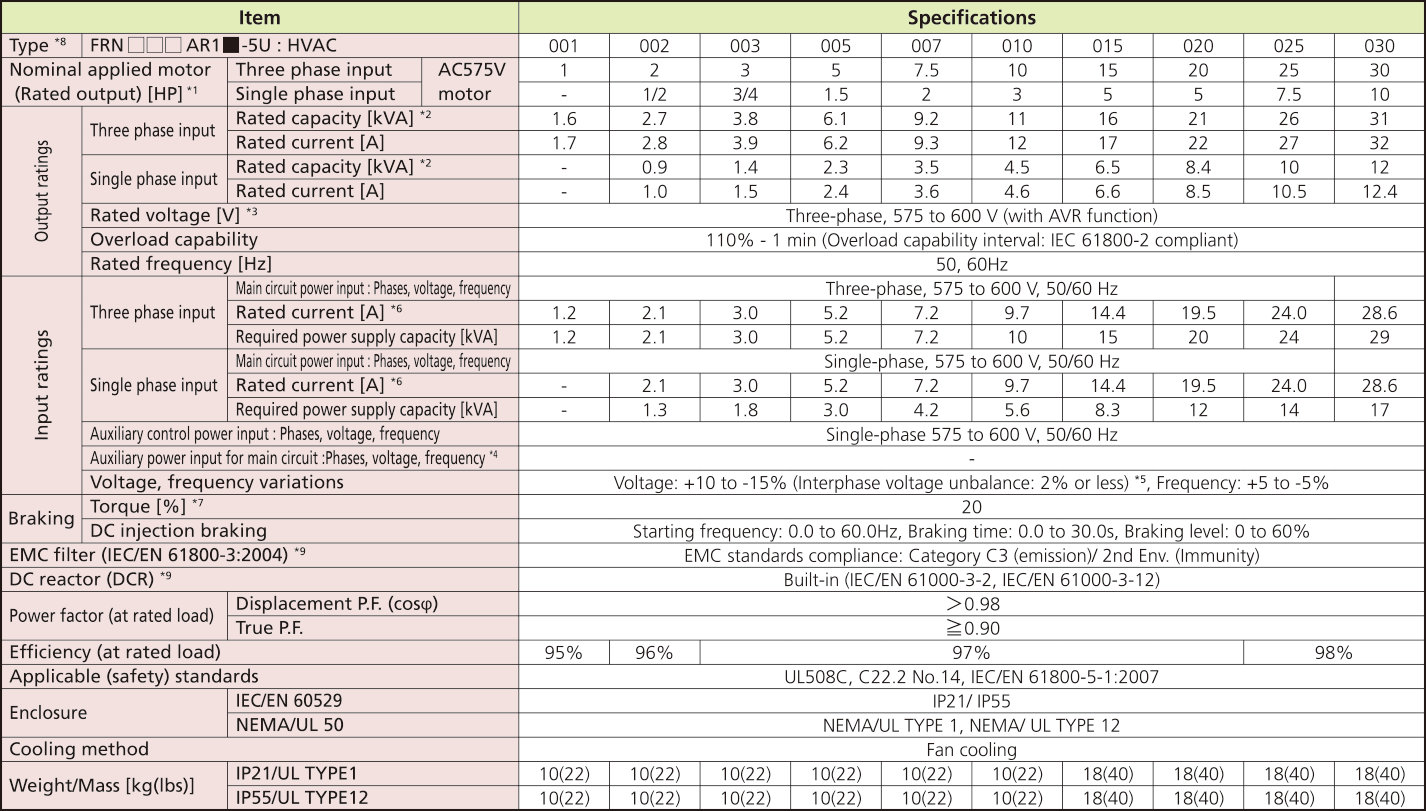
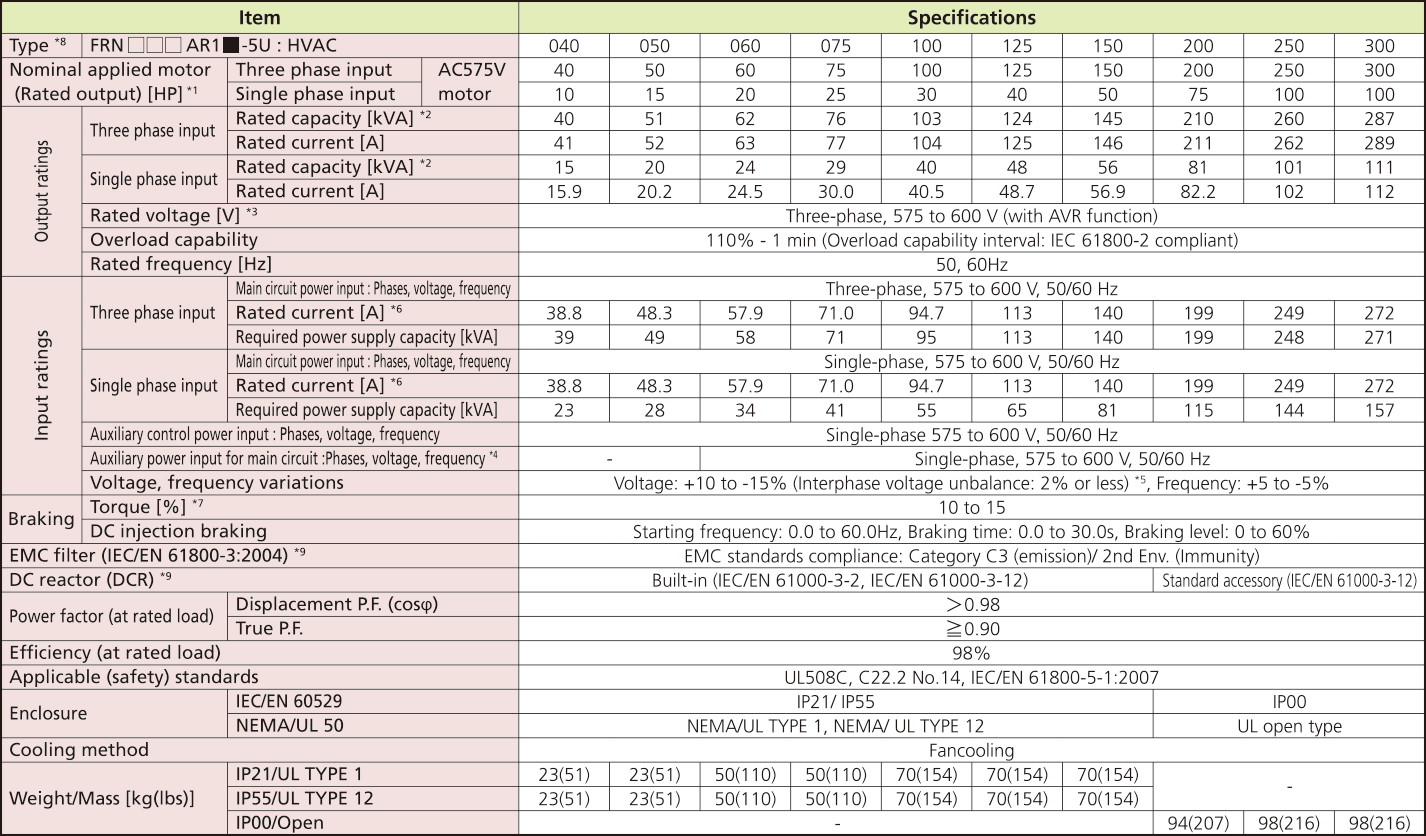
-
*1
-
US 4-pole standard induction motor.
-
*2
-
Rated capacity is calculated by assuming the output rated voltage as 575 V.
-
*3
-
Output voltage cannot exceed the power supply voltage. At single-phase input use, the output voltage may be lower than three-phase input.
-
*4
-
The auxiliary power input is used as an AC power input when combining the unit to DC power supply such as high power factor PWM converter with power regenerative function. (Generally not to be used.)
-
*5
-
Voltage unbalance [%] = (Max. voltage [V] - Min. voltage [V])/Three-phase average voltage [V] x 67 (See IEC61800-3.) If this value is 2 to 3%, use an optional AC reactor (ACR).
-
*6
-
The value is calculated on assumption that the inverter is connected with a power supply 575V, 50Hz and Rsce=120.
-
*7
-
Average braking torque for the motor running alone. (It varies with the efficiency of the motor.)
-
*8
-
The underline (□) replaces an numeric letter depending on the drive capacity. The box (■) replaces an alphabetic letter depending on the enclosure. M (IP21), L (IP55) or S (IP00)
-
*9
-
EMC filters and DCR does not conform to each corresponding standards when single phase input use.
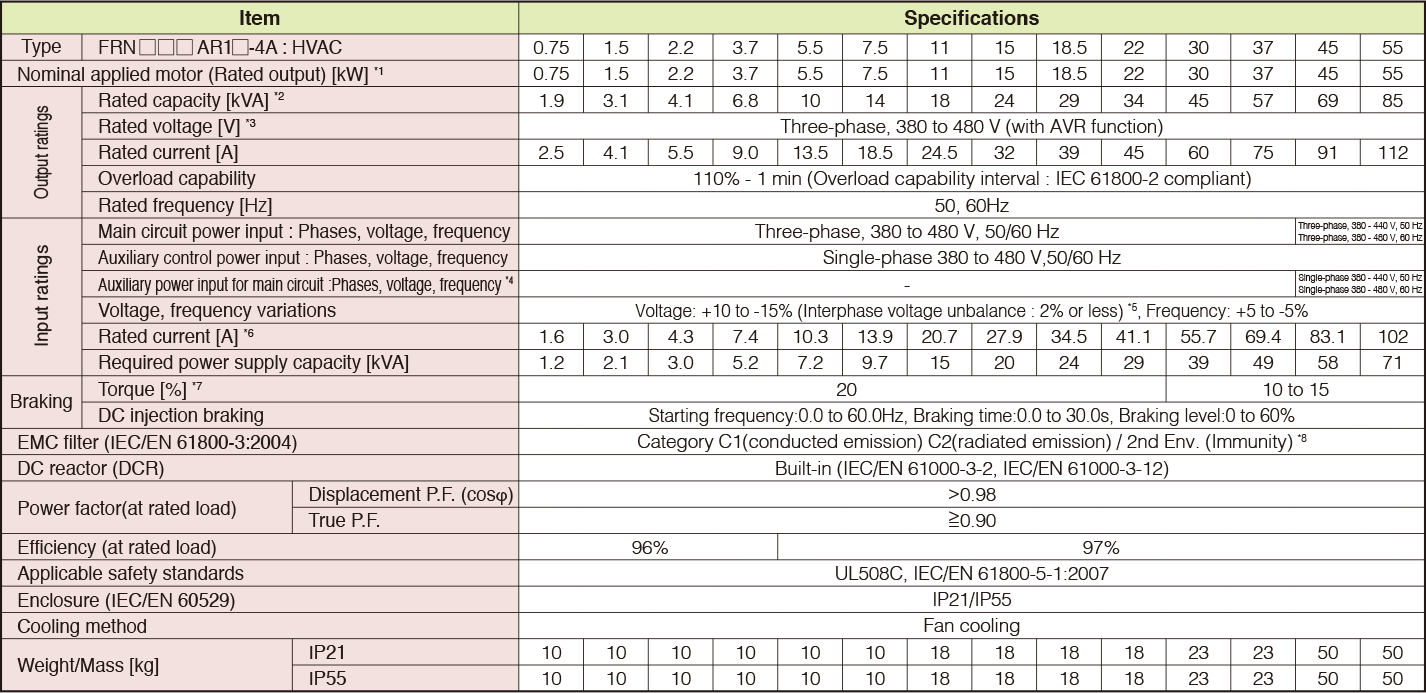
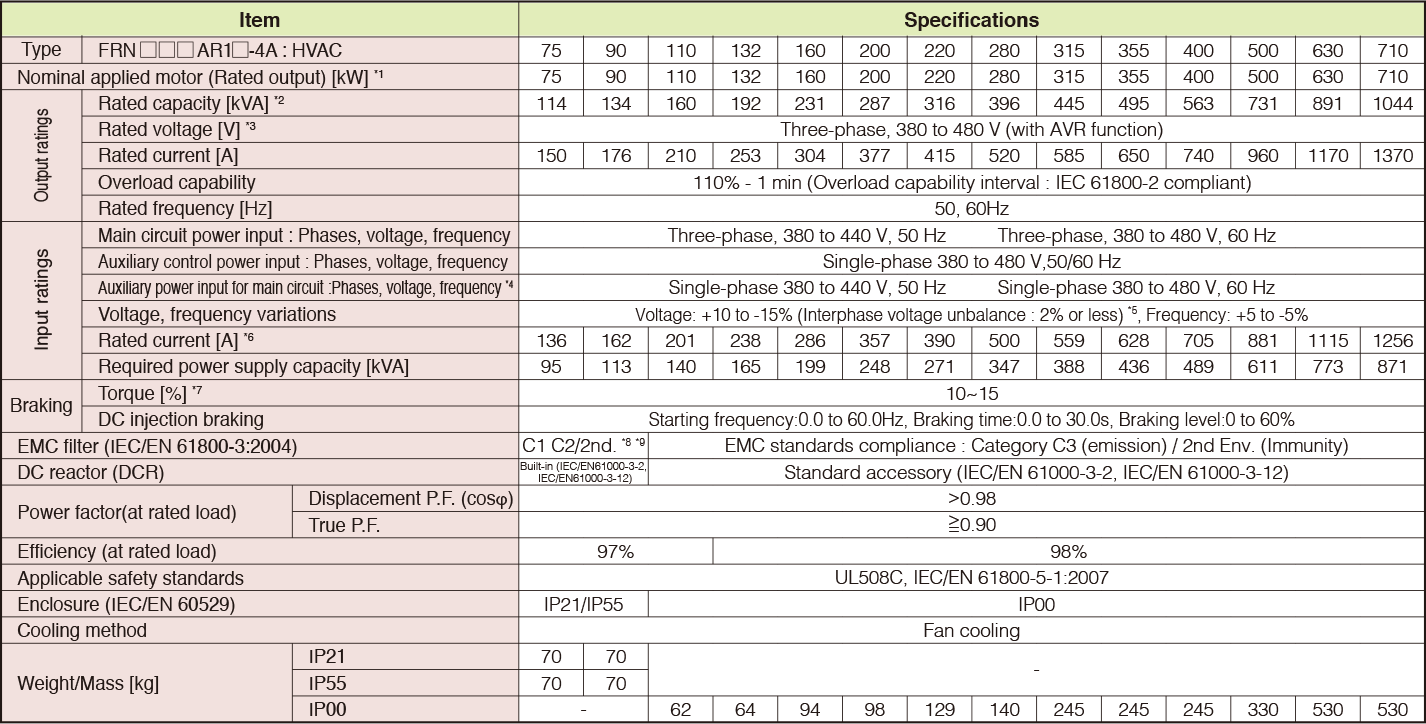
-
*1
-
Fuji 4-pole standard motor.
-
*2
-
Rated capacity is calculated by assuming the output rated voltage as 440 V.
-
*3
-
Output voltage cannot exceed the power supply voltage.
-
*4
-
The auxiliary power input is used as an AC power input when combining the unit to DC power supply such as high power factor PWM converter with power regenerative function. (Generally not to be used.)
-
*5
-
Voltage unbalance [%] = (Max. voltage [V] - Min. voltage [V])/Three-phase average voltage [V] x 67 (See IEC61800-3.) If this value is 2 to 3%, use an optional AC reactor (ACR).
-
*6
-
The value is calculated on assumption that the inverter is connected with a power supply 400V, 50Hz and Rsce=120.
-
*7
-
Average braking torque for the motor running alone. (It varies with the efficiency of the motor.)
-
*8
-
To provide compatibility for EMC category C1, ensure a motor power cable leng h of 10 m or less, a carrier frequency of 4kHz or less, and ground the E1 and E2 terminals.
-
*9
-
Category C1(conducted emission) C2(radiated emission) / 2nd Env. (Immunity)




